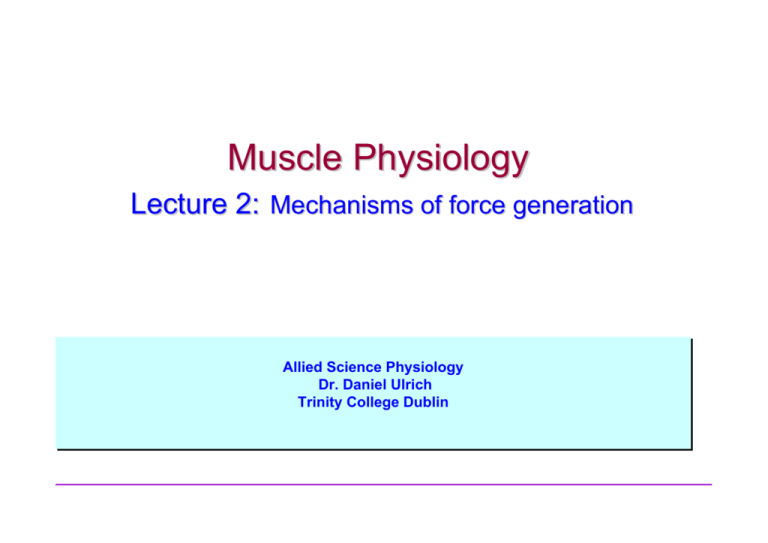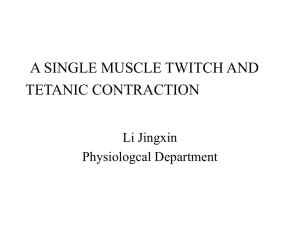Factors affecting the force generated by individual muscle fibers
advertisement

Muscle Physiology Lecture 2: Mechanisms of force generation Allied Allied Science Science Physiology Physiology Dr. Dr. Daniel Daniel Ulrich Ulrich Trinity Trinity College College Dublin Dublin Lecture Outline I. II. Muscle metabolism The Mechanics of Skeletal Muscle Contraction – The Twitch – Factors affecting the force generated by individual muscle fibers – Regulation of the force generated by whole muscle – Velocity of shortening 2 Sources of ATP: Energy systems 3 Metabolic Pathways Figure 12.11 4 Creatine Phosphate (and ATP) system Creatine kinase Creatine phosphate + ADP Creatine + ATP ATP ase ATP + H2O ADP + Pi + H+ + Energy • Creatine phosphate = first source of ATP (up to 30 sec) • Can provide 4–5 times the amount of ATP present in cell at rest • One step process—very rapid • Very limited amount—used up rapidly • Law of Mass Action: – Use of ATP drives the reaction to the right 5 Anaerobic or nonoxidative Glycolysis • When oxygen supply to muscle is limited (during intense exercise), anaerobic glycolysis = primary source of ATP • Breakdown of glucose, O2 absent • High intensity exercise: 20-120 seconds Glucose • • 2 lactic acid + 2 ATP Rapid source of ATP – Only two ATP/glucose – Limited glucose availability – Build up lactic acid (burning sensation) Occurs in cytosol 6 Oxidative Phosphorylation • Primary energy source for Light / Moderate exercise (> 2 minutes) – Muscle stores limited amount of glucose as glycogen • – Substrate of oxidative phosphorylation up to 30 minutes Glucose and fatty acids delivered to muscle by blood • Dominant after 30 minutes • Oxygen supply is adequate • Occurs in mitochondria 7 Energy systems - Activities Examples… Activity / Sport -Marathon (42km) -Running 100m -Running 1,500 m -Running 5,000 m -Running 10,000 m -Downhill racing skiing -Cross country skiing -Swimming 50 m -Swimming 200 m -Swimming 1500 m ATP / PC (%) 98 20 10 5 98 92 30 10 Anaerobic glycolysis (%) Oxidative phosphorylation (%) 5 95 2 25 70 80 55 20 15 2 5 2 65 20 95 5 70 8 The Mechanics of Skeletal Muscle Contraction • The Twitch • Factors affecting the force generated by individual muscle fibers • Regulation of the force generated by whole muscle • Velocity of shortening 9 Twitch Contraction Contraction produced in a muscle fiber in response to a SINGLE ACTION POTENTIAL • Twitch is an all-or-nothing event for a given muscle fiber at rest • Twitch can be defined for a muscle fiber, motor unit, or whole muscle 10 Phases of a Muscle Twitch •Latent period –Time from action potential in muscle cell to onset of contraction (few msec) –Excitation-contraction coupling •Contraction phase –Tension is increasing (10–100 msec) –Crossbridge cycling •Relaxation phase –Tension is decreasing back to zero (longer than contraction phase) Figure 12.12 –Calcium reuptake 11 Isometric vs Isotonic Contraction Isometric Twitch Contraction • Length constant • Contractile elements contract generating tension • Load > Tension – Stretches series elastic elements – Muscle does NOT shorten, load not lifted Isotonic Twitch Contraction • Constant tension • Tension > Load – Load is lifted as muscle shortens Figure 12.13 12 Effect of Load on Tension (Isotonic to Isometric) Figure 12.14 13 Normal Muscle Activity • Some purely isometric contractions occur • Purely isotonic contractions are rare – Even if load is constant, isometric precedes isotonic phase of contraction – Isometric continues (tension increases) until tension exceeds load – Then isotonic contraction begins – Tension remains constant as muscle shortens • Load generally not constant – Load is changing as limb position is changing 14 Graded Muscle Contractions Depends on • Factors affecting the force or tension generated by individual muscle fibers – Frequency of stimulation – Fiber diameter – Changes in fiber length – Extent of fatigue • Regulation of the force/tension generated by whole muscle – Number of fibers contracting: recruitment 15 Frequency of Stimulation Increases in frequency of action potentials in muscle fibers increases tension two ways • Treppe • Summation and tetanus 16 Treppe Independent twitches follow one another closely: peak tension increases to a constant level Cause: Increase cytosolic calcium?? Figure 12.15 17 Basis of summation and tetanus: Isometric Twitch Duration Basis of summation and tetanus: •Action potential : Two msec •Contraction : 10–200 msec •Contractions can overlap and sum Figure 12.16 18 Cause of Summation and Tetanus • • • Amount of tension developed depends on amount of calcium bound to troponin At high frequencies, release exceeds reuptake – Calcium increases in cytosol Eventually saturate system – All troponin has calcium bound to it – Crossbridge cycling maxed out – Maximum tetanic contraction Figure 12.17 19 Fiber Diameter • Force-generating capacity = inherent ability of muscle to generate force • Force-generating capacity depends on number of crossbridges in each sarcomere and geometrical arrangement of sarcomeres • – More crossbridges/sarcomere Æ more force – More sarcomeres in PARALLELÆ more force Number of thick and thin filaments/area = constant – Fiber diameter does vary – Larger diameter Æ more filaments Æ more force 20 Length-Tension Graph Optimum Length • Resting length of muscle at which fiber can develop greatest amount of tension • Due to maximum overlap of thick filament crossbridges and thin filaments Non-Optimum Length • • Figure 12.18 Greater than optimum – Decrease crossbridge overlap Less than optimum – Thin filaments overlap each others – Z lines contact thick filaments In situ, most muscles are at optimum length 21 Factors affecting whole muscle: Recruitment Stimulating more muscle fibers to contract • • • • • Muscle = bundle of muscle fibers More muscle fibers contracting, greater overall muscle tension Recruitment occurs at the level of the motor unit More fibers contracting Æ greater tension Recruit motor units – – • Muscles for delicate movements – • Activate motor neuron activates all muscle fibers in the motor unit Increases in tension occur in steps proportional to size of motor unit Small motor units Muscles for strength – Large motor units 22 Motor Unit Sizes • • • • Number of motor units vary in different muscles Size of motor units vary – Small for delicate movements – Large for strength movements Fiber diameter (and thus strength) varies in motor unit – Small for weaker movements – Large for stronger movements Size of motor unit and fiber diameter often related – Small motor units Æ small fibers – Large motor units Æ large fibers 23 Motor Unit Size Principle • • Small motor units recruited first Large motor units recruited last Figure 12.20 24 Muscle Shortening and Load Figure 12.21 25 Load-Velocity Graph Figure 12.22 26






